2018 MITSUBISHI OUTLANDER III engine
[x] Cancel search: enginePage 362 of 441
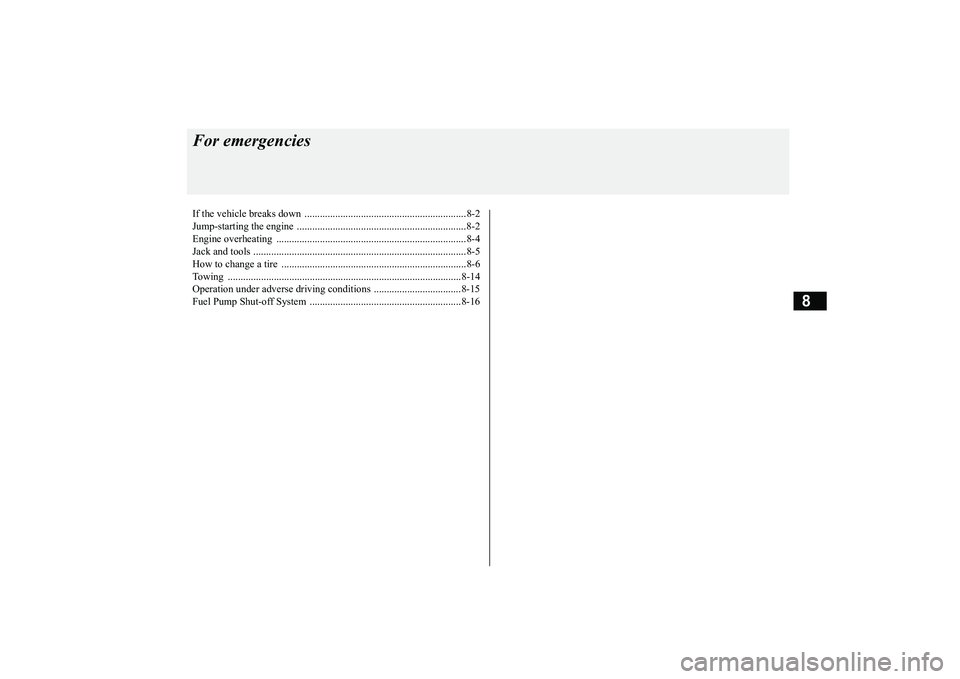
8
For emergenciesIf the vehicle breaks down ...............................................................8-2Jump-starting the engine ..................................................................8-2Engine overheating ..........................................................................8-4Jack and tools ...................................................................................8-5How to change a tire ........................................................................8-6Towing ...........................................................................................8-14Operation under adverse driving conditions
...........
.........
.........
.....8-15
Fuel Pump Shut-off System ...........................................................8-16
BK0249100US.book 1 ページ 2017年5月10日 水曜日 午前8時49分
Page 363 of 441
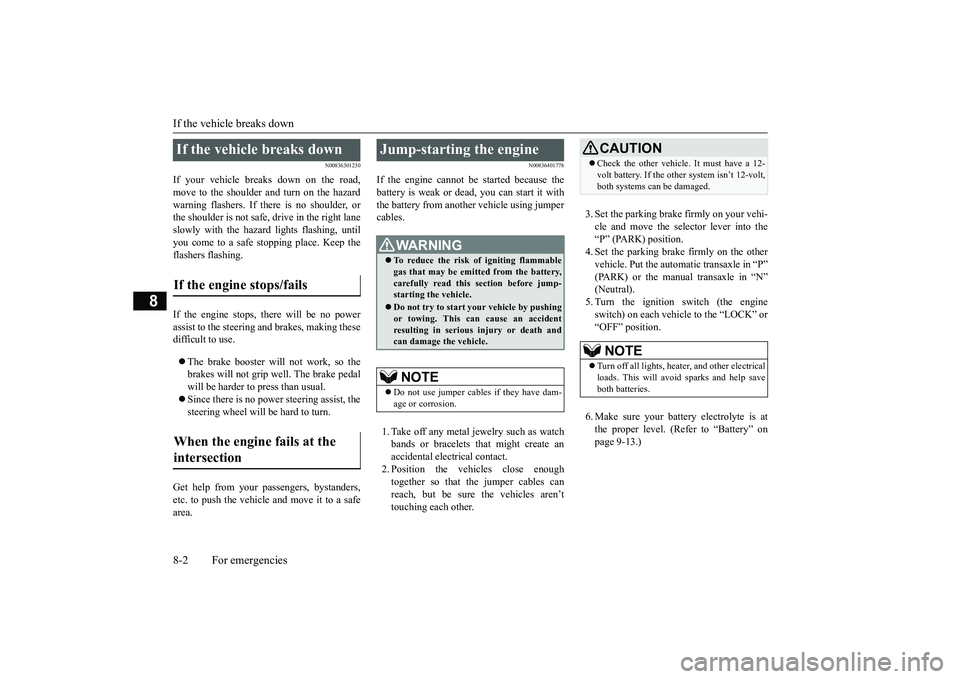
If the vehicle breaks down8-2 For emergencies
8
N00836301230
If your vehicle breaks down on the road,move to the shoulder and turn on the hazardwarning flashers. If there is no shoulder, orthe shoulder is not safe, drive in the right laneslowly with the hazard
lights flashing, until
you come to a safe stopping place. Keep theflashers flashing.If the engine stops, there will be no powerassist to the steering and brakes, making thesedifficult to use.The brake booster will not work, so thebrakes will not grip well. The brake pedalwill be harder to press than usual.Since there is no power steering assist, thesteering wheel will be hard to turn.
Get help from your passengers, bystanders,etc. to push the vehicle
and move it to a safe
area.
N00836401778
If the engine cannot be started because thebattery is weak or de
ad, you can start it with
the battery from anothe
r vehicle using jumper
cables.1. Take off any metal jewelry such as watchbands or bracelets th
at might create an
accidental electrical contact.2. Position the vehi
cles close enough
together so that the jumper cables canreach, but be sure the vehicles aren’ttouching each other.
3. Set the parking brake firmly on your vehi-cle and move the selector lever into the“P” (PARK) position.4. Set the parking brake firmly on the othervehicle. Put the automatic transaxle in “P”5. Turn the ignition switch (the engineswitch) on each vehicle to the “LOCK” or“OFF” position.6. Make sure your battery electrolyte is atthe proper level. (Refer to “Battery” onpage 9-13.)
If the vehicle breaks down If the engine stops/fails When the engine fails at the intersection
Jump-starting the engine
WA R N I N GTo reduce the risk of igniting flammablegas that may be emitted from the battery,carefully read this section before jump-starting the vehicle.Do not try to start you
r vehicle by pushing
or towing. This can cause an accidentresulting in serious
injury or death and
can damage the vehicle.NOTE
Do not use jumper cables if they have dam-age or corrosion.
CAUTIONCheck the other vehicle.
It must have a 12-
volt battery. If the other system isn’t 12-volt,both systems can be damaged.NOTE
Turn off all lights, heat
er, and othe
r electrical
loads. This will avoid sparks and help saveboth batteries.
BK0249100US.book 2 ページ 2017年5月10日 水曜日 午前8時49分
Page 364 of 441
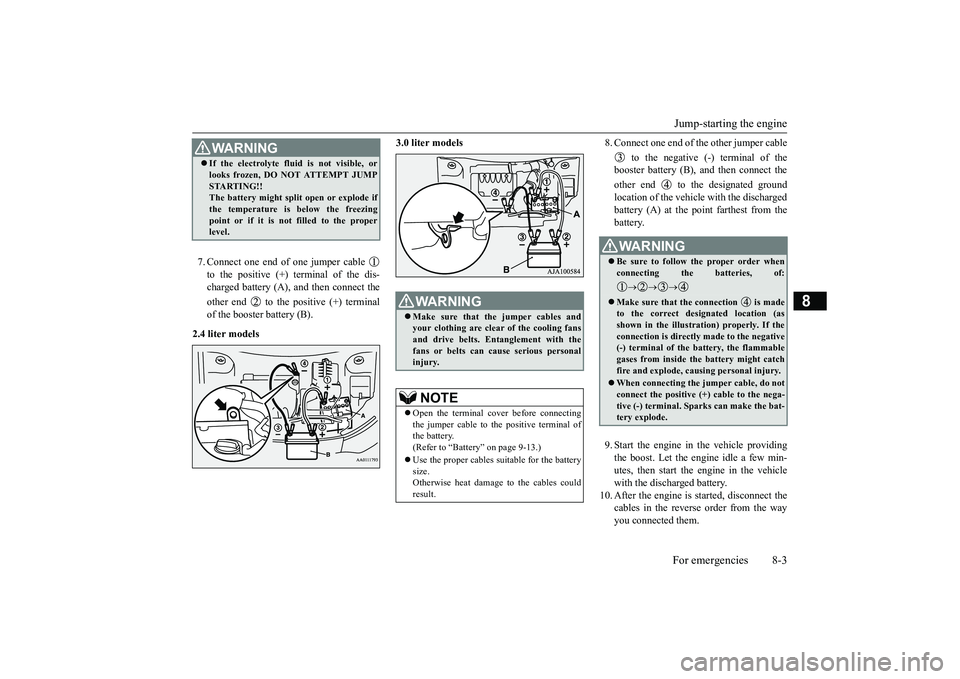
Jump-starting the engineFor emergencies 8-3
8
7. Connect one end of one jumper cable to the positive (+) terminal of the dis-charged battery (A),
and then connect the
other end to the positive (+) terminalof the booster battery (B).
2.4 liter models
3.0 liter models
8. Connect one end of the other jumper cable
to the negative (-) terminal of thebooster battery (B), a
nd then connect the
other end to the designated groundlocation of the vehicl
e with the discharged
battery (A) at the point farthest from thebattery.9. Start the engine in the vehicle providingthe boost. Let the engine idle a few min-utes, then start the engine in the vehiclewith the discharged battery.
10. After the engine is
started, disconnect the
cables in the reverse order from the wayyou connected them.
WA R N I N GIf the electrolyte flui
d is not visible, or
looks frozen, DO NOT ATTEMPT JUMPSTARTING!!The battery might split open or explode ifthe temperature is below the freezingpoint or if it is not filled to the properlevel.
WA R N I N GMake sure that the jumper cables andyour clothing are clear of the cooling fansand drive belts. Entanglement with thefans or belts can ca
use serious personal
injury.NOTE
Open the terminal cover before connectingthe jumper cable to the positive terminal ofthe battery.(Refer to “Battery” on page 9-13.)Use the proper cables suitable for the batterysize.Otherwise heat damage
to the cables could
result.
WA R N I N GBe sure to follow the proper order whenconnecting the batteries, of:
Make sure that the connection is madeto the correct designated location (asshown in the illustration) properly. If theconnection is directly made to the negative(-) terminal of the battery, the flammablegases from inside the battery might catchfire and explode, caus
ing personal injury.
When connecting the jumper cable, do notconnect the positive (+) cable to the nega-tive (-) terminal. Sparks can make the bat-tery explode.
BK0249100US.book 3 ページ 2017年5月10日 水曜日 午前8時49分
Page 365 of 441
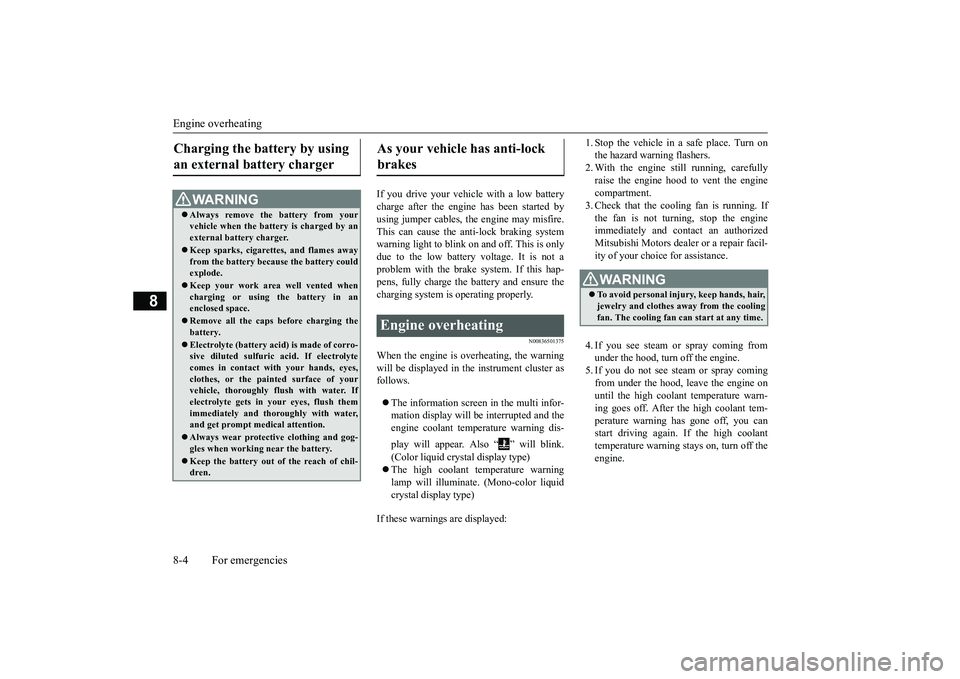
Engine overheating8-4 For emergencies
8
If you drive your vehicl
e with a low battery
charge after the engine has been started byusing jumper cables, th
e engine may misfire.
This can cause the anti-lock braking systemwarning light to blink on
and off. This is only
due to the low battery voltage. It is not aproblem with the brake system. If this hap-pens, fully charge the battery and ensure thecharging system is operating properly.
N00836501375
When the engine is overheating, the warningwill be displayed in th
e instrument cluster as
follows.The information screen in the multi infor-mation display will be interrupted and theengine coolant temp
erature warning dis-
play will appear. Also “ ” will blink.(Color liquid crystal display type)lamp will illuminate.
(Mono-color liquid
crystal display type)
If these warnings are displayed:
1. Stop the vehicle in a safe place. Turn onthe hazard warning flashers.2. With the engine st
ill running, carefully
raise the engine hood to vent the enginecompartment.3. Check that the cooling fan is running. Ifthe fan is not turn
ing, stop the engine
immediately and cont
act an authorized
Mitsubishi Motors dealer or a repair facil-ity of your choice for assistance.4. If you see steam or spray coming fromunder the hood, turn off the engine.5. If you do not see steam or spray comingfrom under the hood, leave the engine onuntil the high coolant
temperature warn-
ing goes off. After the high coolant tem-perature warning has gone off, you canstart driving again. If the high coolanttemperature warning stays on, turn off theengine.
Charging the battery by using an external battery charger
WA R N I N GAlways remove the
battery from your
vehicle when the battery is charged by anexternal battery charger.Keep sparks, cigarette
s, and flames away
from the battery because the battery couldexplode.Keep your work area well vented whencharging or using
the battery in an
enclosed space.Remove all the caps before charging thebattery.Electrolyte (battery acid) is made of corro-sive diluted sulfuric acid. If electrolytecomes in contact with your hands, eyes,clothes, or the pain
ted surface of your
vehicle, thoroughly
flush with water. If
electrolyte gets in your eyes, flush themimmediately and thor
oughly with water,
and get prompt medical attention.Always wear protective clothing and gog-gles when working near the battery.Keep the battery out of the reach of chil-dren.
As your vehicle has anti-lock brakes Engine overheating
WA R N I N GTo avoid personal injury, keep hands, hair,jewelry and clothes aw
ay from the cooling
fan. The cooling fan ca
n start at any time.
BK0249100US.book 4 ページ 2017年5月10日 水曜日 午前8時49分
Page 366 of 441
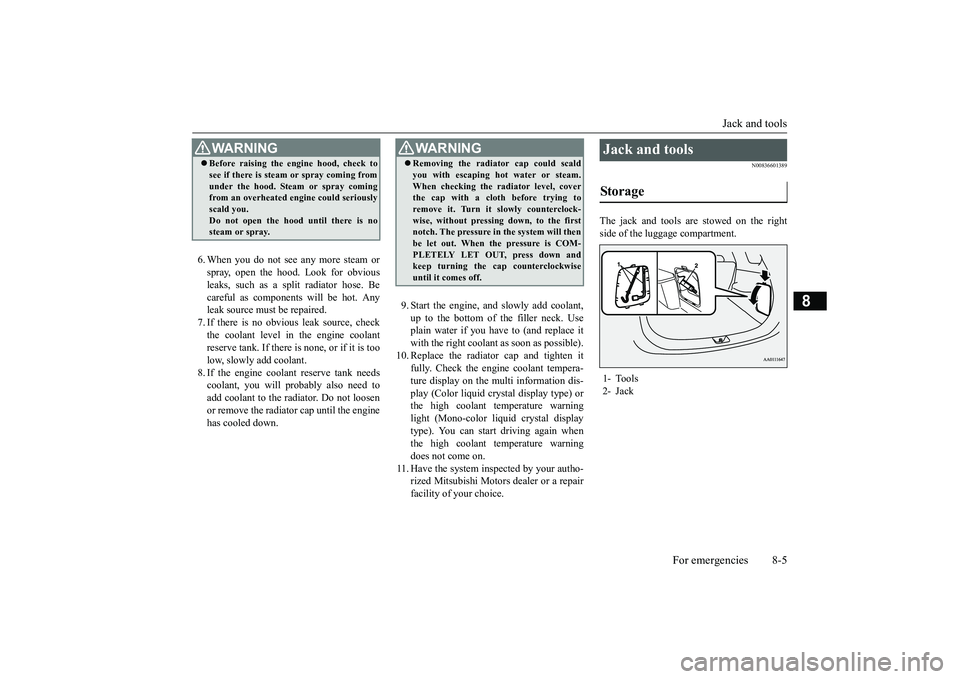
Jack and tools
For emergencies 8-5
8
6. When you do not see any more steam orspray, open the hood. Look for obviousleaks, such as a split radiator hose. Becareful as components will be hot. Anyleak source must be repaired.7. If there is no obvious leak source, checkthe coolant level in the engine coolantreserve tank. If there is
none, or if it is too
low, slowly add coolant.8. If the engine coolant reserve tank needscoolant, you will probably also need toadd coolant to the radiator. Do not loosenor remove the radiator cap until the enginehas cooled down.
9. Start the engine, a
nd slowly add coolant,
up to the bottom of the filler neck. Useplain water if you have to (and replace itwith the right coolant as soon as possible).
10. Replace the radiator cap and tighten it
fully. Check the engine coolant tempera-ture display on the mu
lti information dis-
play (Color liquid crystal display type) orthe high coolant temperature warninglight (Mono-color liqui
d crystal display
type). You can start driving again whenthe high coolant temperature warningdoes not come on.
11. Have the system inspected by your autho-
rized Mitsubishi Motors
dealer or a repair
facility of your choice.
N00836601389
The jack and tools are stowed on the rightside of the luggage compartment.
WA R N I N GBefore raising the en
gine hood, check to
see if there is steam or spray coming fromunder the hood. Steam or spray comingfrom an overheated en
gine could seriously
scald you.Do not open the hood until there is nosteam or spray.
WA R N I N GRemoving the radiat
or cap could scald
you with escaping hot water or steam.When checking the radiator level, coverthe cap with a cloth before trying toremove it. Turn it slowly counterclock-wise, without pressing down, to the firstnotch. The pressure in the system will thenbe let out. When the pressure is COM-PLETELY LET OUT, press down andkeep turning the cap counterclockwiseuntil it comes off.
Jack and tools Storage 1- Tools2- Jack
BK0249100US.book 5 ページ 2017年5月10日 水曜日 午前8時49分
Page 367 of 441
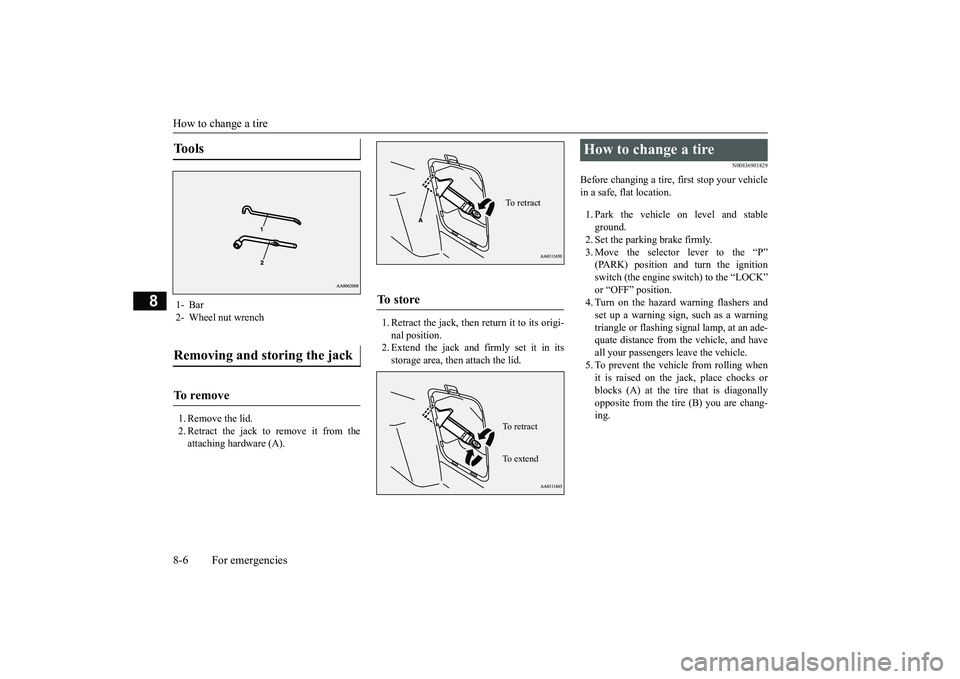
How to change a tire8-6 For emergencies
8
1. Remove the lid.2. Retract the jack to remove it from theattaching hardware (A).
1. Retract the jack, then return it to its origi-nal position.2. Extend the jack and firmly set it in itsstorage area, then attach the lid.
N00836901829
Before changing a tire, first stop your vehiclein a safe, flat location.1. Park the vehicle on level and stableground.2. Set the parking brake firmly.3. Move the selector
lever to the “P”
switch (the engine switch) to the “LOCK”or “OFF” position.4. Turn on the hazard warning flashers andset up a warning sign, such as a warningtriangle or flashing signal lamp, at an ade-quate distance from the vehicle, and haveall your passengers leave the vehicle.5. To prevent the vehicle from rolling whenit is raised on the jack, place chocks orblocks (A) at the ti
re that is diagonally
opposite from the tire (B) you are chang-ing.
Tools 1- Bar2- Wheel nut wrenchRemoving and storing the jack To r e m o v e
To s t o r e
To retractTo r e t r a c tTo e x t e n d
How to change a tire
BK0249100US.book 6 ページ 2017年5月10日 水曜日 午前8時49分
Page 370 of 441
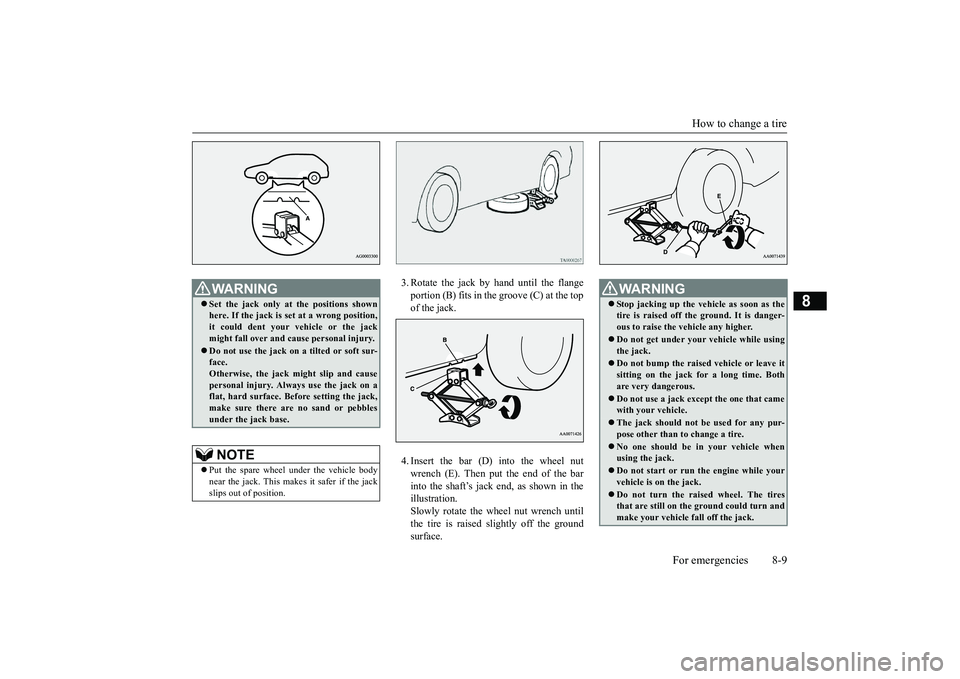
How to change a tire
For emergencies 8-9
8
3. Rotate the jack by hand until the flangeportion (B) fits in the groove (C) at the topof the jack.4. Insert the bar (D) into the wheel nutwrench (E). Then put the end of the barinto the shaft’s jack end, as shown in theillustration.Slowly rotate the wheel nut wrench untilthe tire is raised slightly off the groundsurface.
WA R N I N GSet the jack only at
the positions shown
here. If the jack is se
t at a wrong position,
it could dent your vehicle or the jackmight fall over and ca
use personal injury.
Do not use the jack on a tilted or soft sur-face.Otherwise, the jack might slip and causepersonal injury. Always
use the jack on a
flat, hard surface. Before setting the jack,make sure there are no sand or pebblesunder the jack base.NOTE
Put the spare wheel under the vehicle bodynear the jack. This makes it safer if the jackslips out of position.
WA R N I N GStop jacking up the ve
hicle as soon as the
tire is raised off the ground. It is danger-ous to raise the ve
hicle any higher.
Do not get under your vehicle while usingthe jack.Do not bump the raised
vehicle or leave it
sitting on the jack for a long time. Bothare very dangerous.Do not use a jack except the one that camewith your vehicle.The jack should not
be used for any pur-
pose other than to change a tire.No one should be
in your vehicle when
using the jack.Do not start or run
the engine while your
vehicle is on the jack.Do not turn the raised wheel. The tiresthat are still on the ground could turn andmake your vehicle fall off the jack.
BK0249100US.book 9 ページ 2017年5月10日 水曜日 午前8時49分
Page 377 of 441
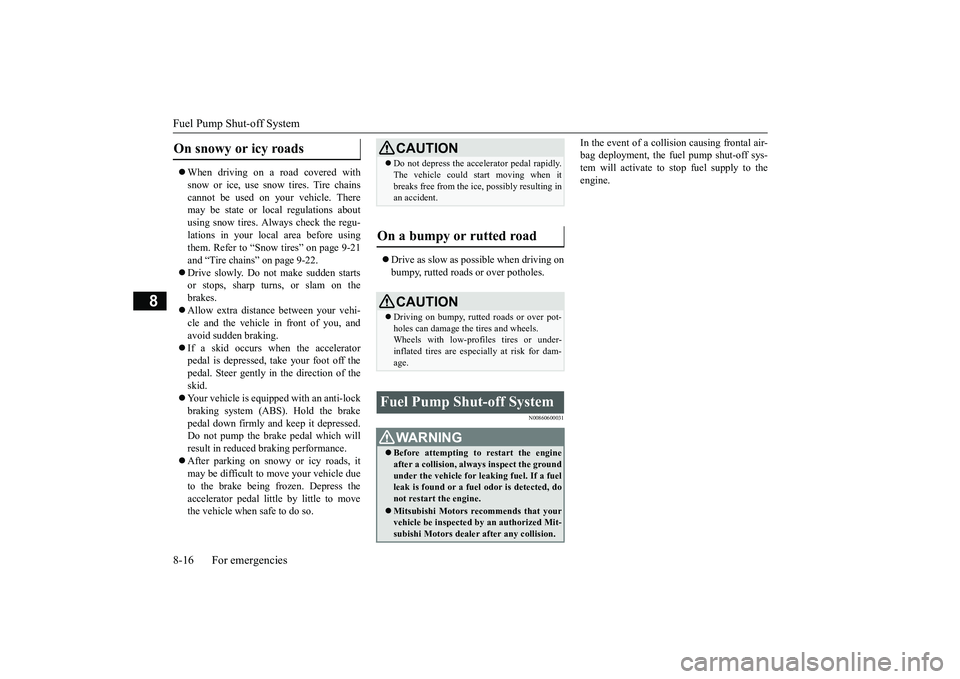
Fuel Pump Shut-off System8-16 For emergencies
8
When driving on a road covered withsnow or ice, use s
now tires. Tire chains
cannot be used on your vehicle. Theremay be state or local regulations aboutusing snow tires. Al
ways check the regu-
lations in your local area before usingthem. Refer to “Snow tires” on page 9-21and “Tire chains” on page 9-22.Drive slowly. Do not make sudden startsor stops, sharp turns, or slam on thebrakes.Allow extra distance
between your vehi-
cle and the vehicle in front of you, andavoid sudden braking.If a skid occurs when the acceleratorpedal is depressed, take your foot off thepedal. Steer gently in the direction of theskid.Your vehicle is equipped with an anti-lockbraking system (ABS). Hold the brakepedal down firmly and keep it depressed.Do not pump the brake pedal which willresult in reduced braking performance.After parking on snowy or icy roads, itmay be difficult to move your vehicle dueto the brake being frozen. Depress theaccelerator pedal little by little to movethe vehicle when safe to do so.
Drive as slow as pos
sible when driving on
bumpy, rutted roads or over potholes.
N00860600031
In the event of a collision causing frontal air-bag deployment, the fuel pump shut-off sys-tem will activate to st
op fuel supply to the
engine.
On snowy or icy roads
CAUTIONDo not depress the acce
lerator pedal rapidly.
The vehicle could start moving when itbreaks free from the
ice, possibly resulting in
an accident.
On a bumpy or rutted road
CAUTIONDriving on bumpy, rutted roads or over pot-holes can damage th
e tires and wheels.
Wheels with low-profiles tires or under-inflated tires are especially at risk for dam-age.
Fuel Pump Shut-off System
WA R N I N GBefore attempting to restart the engineafter a collision, alw
ays inspect the ground
under the vehicle for leaking fuel. If a fuelleak is found or a fuel
odor is detected, do
not restart the engine.Mitsubishi Motors recommends that yourvehicle be inspected by
an author
ized Mit-
subishi Motors dealer
after any collision.
BK0249100US.book 16 ページ 2017年5月10日 水曜日 午前8時49分